There are a lot of different ways to analyze shock and vibration data. You can use standalone software packages or, my preference, you can develop your own analysis program or algorithm that does exactly what you need. After all, in the world of shock and vibration testing, each application is a little different.
Even within the world of computational programs there are many different options, each with their own benefits and drawbacks. So in this post we'll discuss 7 well known computing platforms that work great for analyzing shock and vibration data:
Then we'll go over what the best programming option is for you, and we'll finish up with some extra resources for your shock and vibration analysis.LabVIEW
Most engineering companies will likely have a couple LabVIEW licenses to interface with their National Instruments data acquisition hardware and analyze data in real time. LabVIEW is a development environment specifically designed for engineers and scientists analyzing data. As such, it’s a popular tool for vibration testing! National Instruments is the world leader in hardware for data acquisition; so it makes sense that their software is also very popular and pairs well with their hardware. Designing analysis programs with LabVIEW may be easier to those with less programming knowledge because of the graphical programming language they use, shown in Figure 1.

A full LabVIEW license costs $2,999 and vibration customers may be interested in their Sound and Vibration Toolkit for another $1,999. It can definitely get expensive quickly but is a great solution for data analysis, especially in real-time controls applications.
MATLAB
MATLAB is a programming language specifically developed for linear algebraic operations. Because of this initial core design and focus, it is a hugely popular tool for data analysis. Most engineers would have used MATLAB is college and entered the workforce already with a knowledge and preference for this (MathWorks is smart with their pricing to offer significant discounts to universities and students).
The big disadvantage of MATLAB is that it's not free; a commercial license will cost $2,150. They also charge more, typically $1,000, for additional toolboxes (here's a full price list of the MATLAB products); and I'd recommend the signal processing toolbox for vibration analysis. Don't worry though, I didn't use any functions in that toolbox for the examples covered in my vibration analysis basics blog; some screen shots of those analysis scripts are provided in Figure 2.
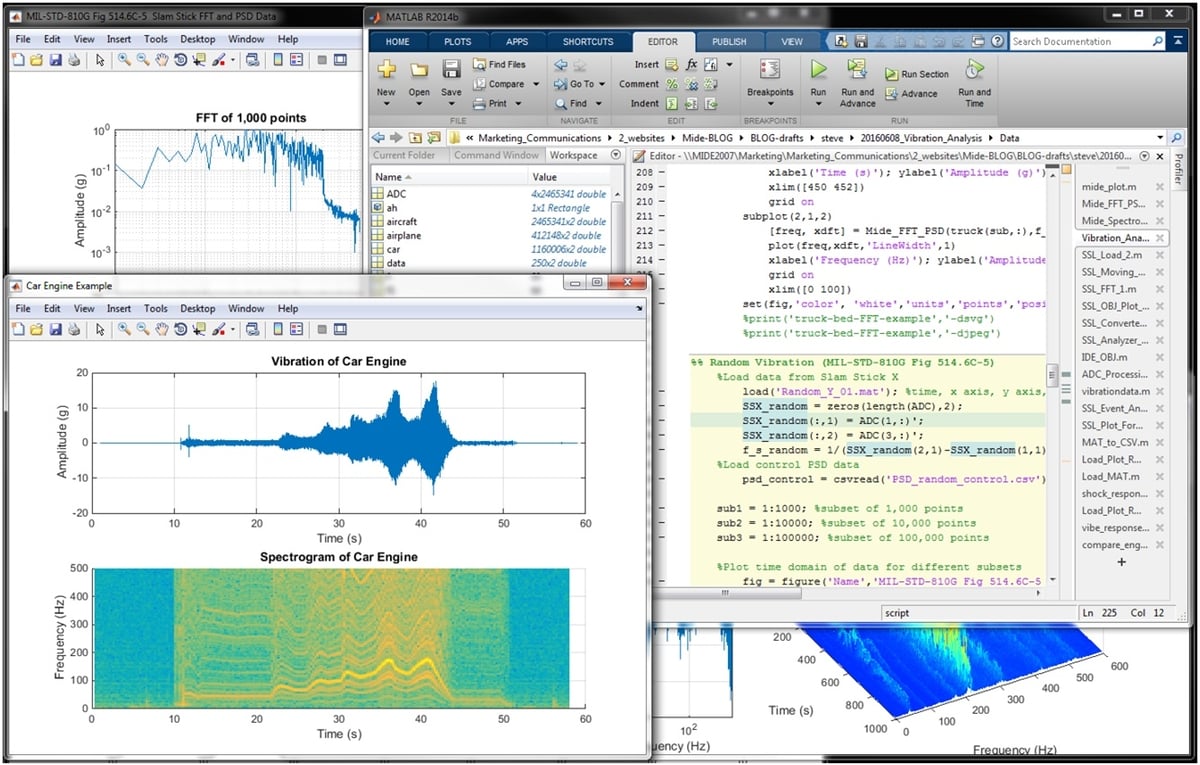
If code base programming seems daunting, MATLAB does have their Simulink block diagram environment. This is a compelling product that can help reduce human programming induced errors and allow teams of analysts to integrate their algorithms a little easier. A single commercial license is $3,350 (in addition to a MATLAB license). Simulink also lets engineers interface with hardware such as National Instruments, Raspberry Pi and Arduino; but these hardware supports will cost you. Simulink is great for analyzing data in real time (another couple thousand dollars) and offers incredible customization in addition to built-in analysis capabilities.
For more information on MATLAB and some of its benefits, this blog entitled What is Matlab – Where and Why to Use It is a good read.
Python
Python is a free, open source, and very versatile programming language (for these reasons we use it to develop our enDAQ Lab software (formerly Slam Stick Lab vibration analysis software). Their NumPy and SciPy packages have similar functions to MATLAB. Python is a pretty elegant and intuitive programming language compared to MATLAB. It was created to be a generic language that is easy to read; and they definitely succeeded with that! Python is universally accepted as the better alternative to MATLAB for other programming needs besides data analysis.
But if you ask what’s better, MATLAB or Python for vibration analysis, you may start a heated debate because they both have benefits and disadvantages. We recently did some testing to compare MATLAB and Python for vibration analysis and came to the conclusion that for basic analysis (including FFTs) Python can match and even beat MATLAB computation times; but the programmer may need to do a bit of digging to find and download all the necessary libraries. But these libraries will be free!
As a MATLAB user I found the Anaconda distribution of Python and its most popular libraries very helpful. The Spyder development environment, shown in Figure 3, has a similar interface and feel to MATLAB for those with MATLAB experience.
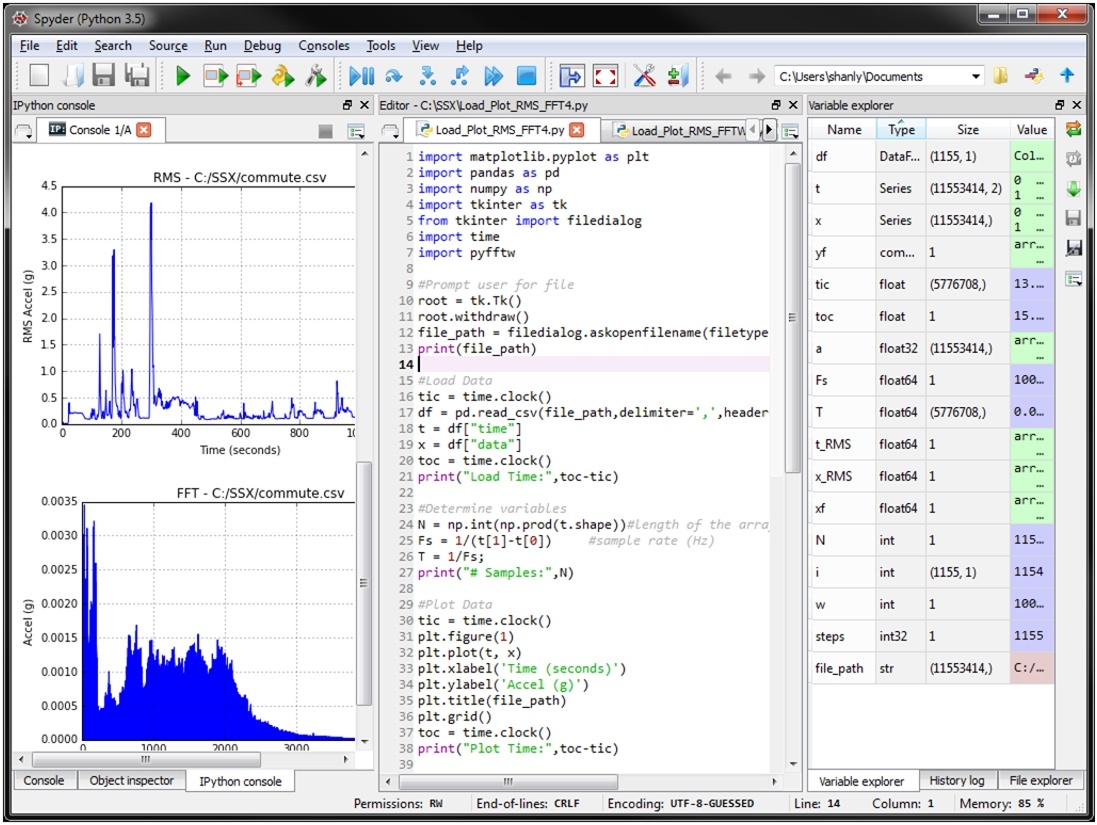
Python is gaining popularity because it’s free and the community is generating a wide variety of versatile libraries that are publicly available through GitHub. A quick search finds the PyDAQmx library that interfaces with National Instrument’s drivers. Again Python is free so it’s becoming a compelling alternative, especially as the offerings and capabilities continue to grow and improve.
enDAQ Cloud
The enDAQ Cloud platform has a lot of capabilities in the free tier that doesn't require any programming to analyze and visualize shock and vibration data. But in their paying tiers (starting at 100/month) the user can write their own Python code, or ask enDAQ engineers to do this for them, to do some completely customized analysis and visualization - all into a single page view "report" or dashboard.
These reports can then be shared with colleagues or customers in its interactive form. So the big benefit of this option over running Python locally is that no installation is required, all done from the browser and sharing the output is much easier. This also lets developers deploy custom code for non-developers to then use with a click of a button.

The custom reports are generated with custom code that allows for the user to pull in a variety of other open Python libraries such as:
- Pandas for storing and analysis of tabular data
- Numpy for some basic mathematic operations
- SciPy's Signal for advanced signal processing (PSDs, digital filters, etc.)
- Plotly for generating the beautiful and interactive plots
- Requests for pulling in data from other external APIs
enDAQ is also working on releasing a new open-source package to provide some helper functions to not only do some of the vibration analysis with simple 1-liners of code, but also generate the plots. This open-source package will then be available in the report generation, but it will also be available freely for all to utilize!
In true enDAQ fashion, all of our pricing is and will always be very public, shown below! You can see that even our free tier lets you generate unlimited standard reports. Customers on paying tiers have access to more data, the API, and the ability to customize reports with their own code. You can pay one month at a time if only needed for a short time, or sign on for an annual subscription to save 17%.

The enDAQ Cloud stands out for pairing the customization you get with writing your own code, with the convenience of the cloud and clean presentation of single-page test reports. Once they release the open source package this will help make those reports even easier to customize, but it will also provide a tool for the broader engineering community to use for free to help analyze and visualize shock and vibration data!
GNU Octave
GNU Octave is a scientific programming language that is largely considered a direct free replacement to MATLAB. Many users find it very similar to MATLAB; it's so similar that it can even offer exact compatibility with some simpler MATLAB code!
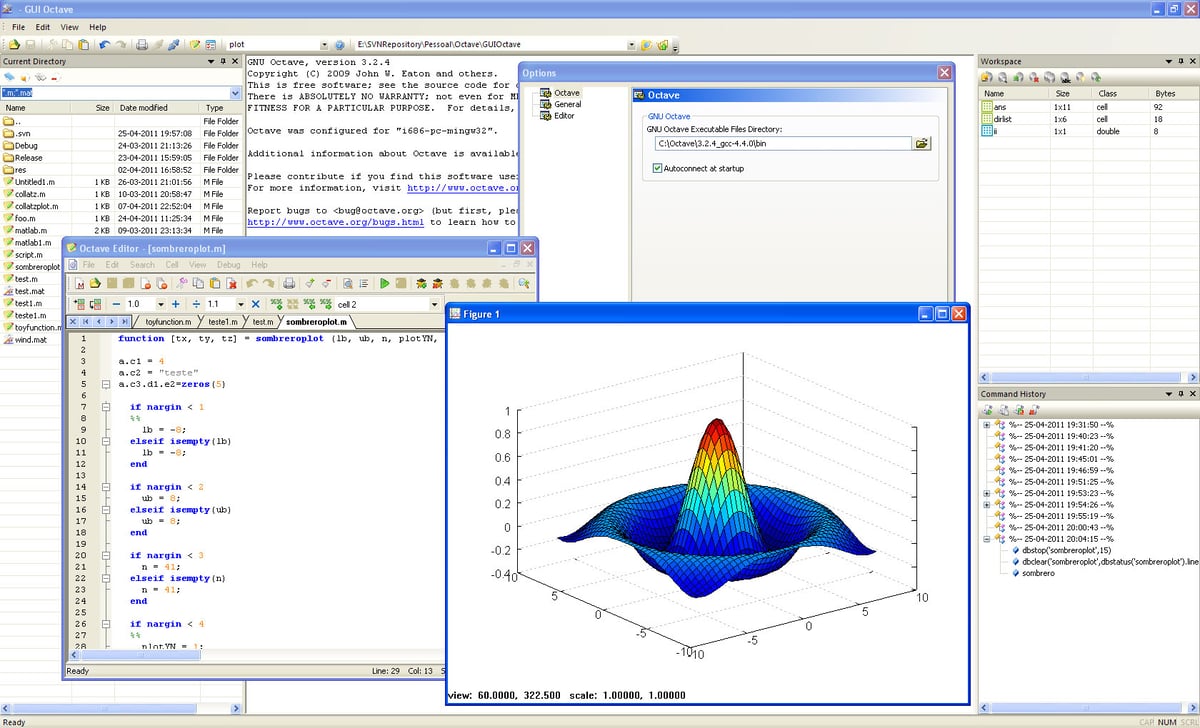
Although it's free, it isn't new; GNU Octave has been around since 1988. I personally have never used it (I'm a MATLAB guy, and now becoming a bit of a Python user as enDAQ continues to develop its enDAQ Lab vibration analysis software); but I can say that I've heard from a lot of our customers how effective this software can be for analyzing vibration data, or any numerical analysis needs. Its plotting capabilities are especially impressive.
Scilabs
Scilabs is another open source and free option for numerical computing. I don't have any experience with Scilabs but it seems that their ability to interconnect with third party applications, including LabVIEW is its most attractive feature.
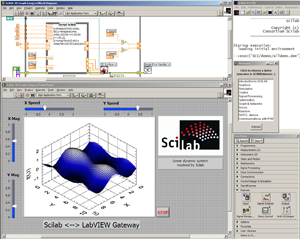
FreeMat
FreeMat was specifically developed to be as the name implies... a free version of MATLAB. Although it can offer the same interface, language, and basic capabilities, in my experience I found it to pale in comparison to MATLAB for large data sets. And vibration analysis typically deals with millions of samples so I wouldn't recommend FreeMat. The other free open source options, especially Python or GNU Octave, are better free alternatives.
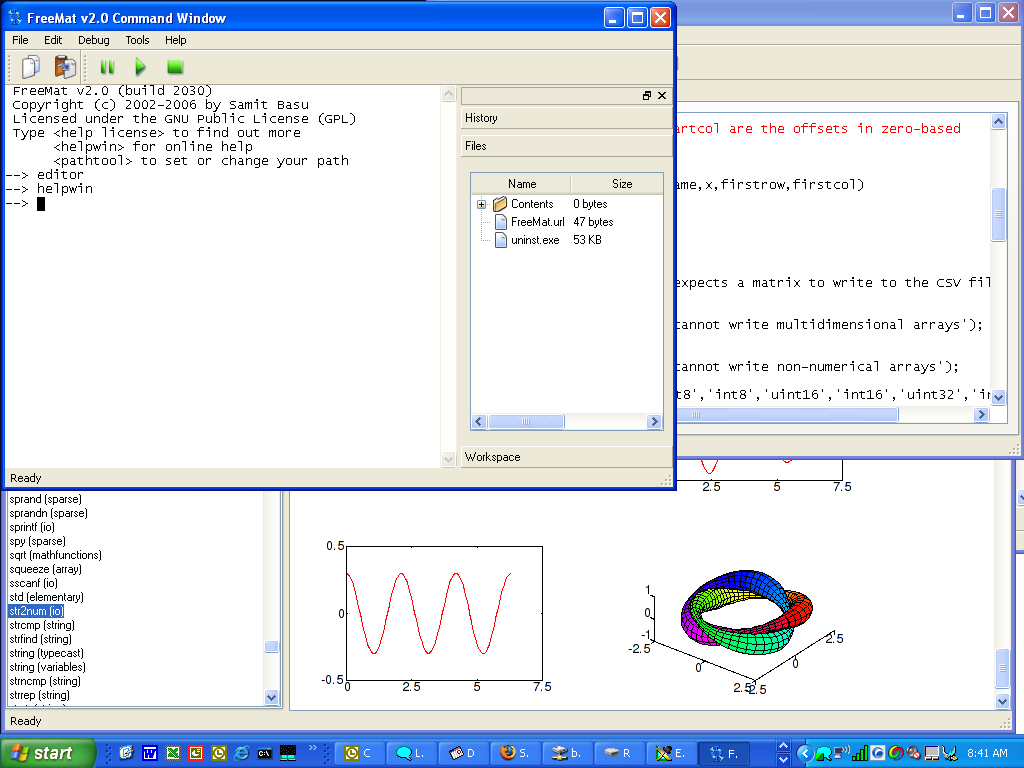
What's Right for Me?
There are three main considerations before you can decide which option is best for you.
Cost
If you work at a larger company, the cost of MATLAB or LabVIEW is probably an insignificant expense; and its even very likely that your company already has licenses to use these programming platforms. But for smaller companies and consultants, cost may be a major concern; in which case, you should strongly consider the open source options. I've had good luck with Python and I've heard a lot of great things about GNU Octave.
Post Processing or Real Time Analysis
If the products you will be using acquire the data and export it then the software will “only” need to do the post-processing. This would be the case for a vibration data logger. All the options I've laid out in this blog will work for post processing vibration data; but my favorite is MATLAB.
But for applications that require real-time (or near real-time with a buffer) data streaming and analysis will limit the options available. Real-time data streaming and processing is needed for typical modal analysis, and for controls applications (where an action is taken based upon recorded data). In these applications Simulink or LabVIEW are the best options.
Programming Experience and Analysis Complexity
Writing custom analysis and simulation programs will require some advanced knowledge of the computing language and analysis fundamentals; but it is the preferred path for most post-processing analysis applications. In many applications though there will be a need for doing analysis based upon certain conditions specific to your test. For example, if I performed a two hour long test on an aircraft component, I may want to develop a script that looks through the data and runs FFTs if/when certain conditions are met. Doing this fairly simple analysis that has a couple if-statements may be more difficult in a standalone GUI.
That being said, not everyone feels comfortable with writing code and developing algorithms. These folks could consider the graphical programming languages/environments or may prefer standalone GUI packages. If you'd prefer a standalone software, check out our list of 8 different vibration analysis software packages; these include both free and paid options. Standalone graphical user interfaces (GUIs) are most useful for providing that initial overview of your data and performing some preliminary analysis.
Conclusion & More Resources
I hope this post gave you a good overview of the best options for vibration analysis programming.
If you'd like to learn a little more about various aspects in shock and vibration testing and analysis, download our free Shock & Vibration Testing Overview eBook. In there are some examples, background, and a ton of links to where you can learn more. And as always, don't hesitate to reach out to us if you have any questions!
Related Posts:
- Top 9 Accurate Wireless Vibration Monitoring Systems
- Top 10 Vibration Analysis Software Packages
- Top 12 Vibration Metrics and How to Calculate Them
For more on this topic, visit our dedicated Vibration Loggers & Vibration Sensors resource page. There you’ll find more blog posts, case studies, webinars, software, and products focused on your vibration testing and analysis needs.

